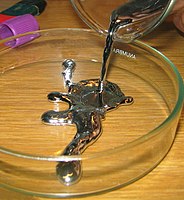
Photo from wikipedia
Electrochemical decomposition of lipopolysaccharide (LPS) was firstly investigated over titania nanotubes (TNTs) arrays electrode. The TNTs layer of this electrode consisted of numerous tubular structures which arranged tightly, and the… Click to show full abstract
Electrochemical decomposition of lipopolysaccharide (LPS) was firstly investigated over titania nanotubes (TNTs) arrays electrode. The TNTs layer of this electrode consisted of numerous tubular structures which arranged tightly, and the average diameter of each nanotube is 100 ± 5 nm. The degradation of LPS and polysaccharides followed pseudo-first-order kinetics. The optimal LPS removal ratio was nearly 80 %. The endotoxin toxicity of LPS steadily decreased during the electrolysis process. The acute toxicity of the intermediates increased suddenly at the beginning of electrochemical degradation process (< 5 min), then maintained high inhibition ratio (> 95 %) for about 150 min, and decreased significantly (< 10 %) after electrolysis for 240 min. After 20 min of electrolysis, LPS with molecular weight of 116,854 Da was transformed into small molecular compounds with molecular weights of 59,312 - 12,209 Da. Possible degradation and detoxification mechanisms of LPS including electric-field-force-driving accumulation, adsorption and direct electron transfer on TNTs arrays electrode, and •OH oxidation were proposed. This study underscores that electrochemical technique can be applied to eliminate and decrease the toxicity of LPS from contaminated water.
Journal Title: Journal of hazardous materials
Year Published: 2020
Link to full text (if available)
Share on Social Media: Sign Up to like & get
recommendations!